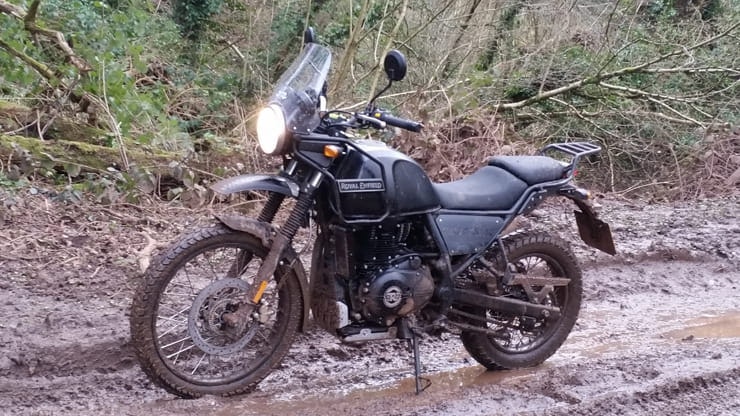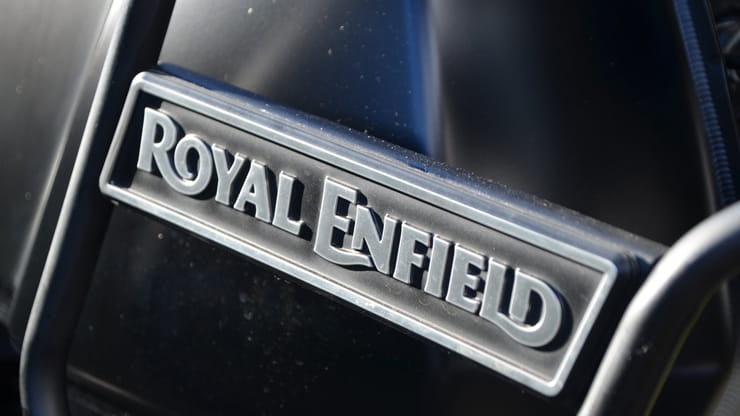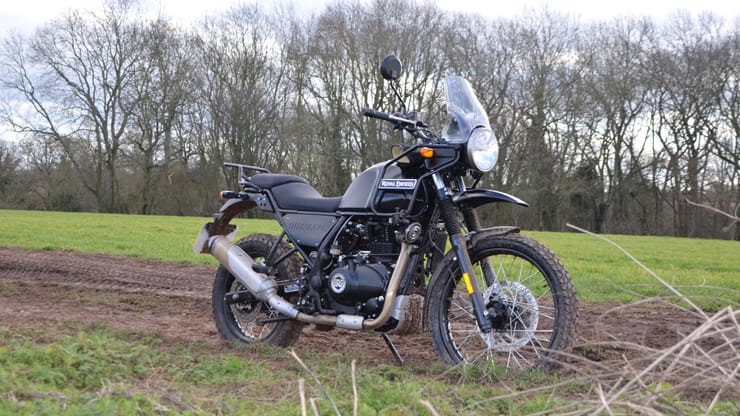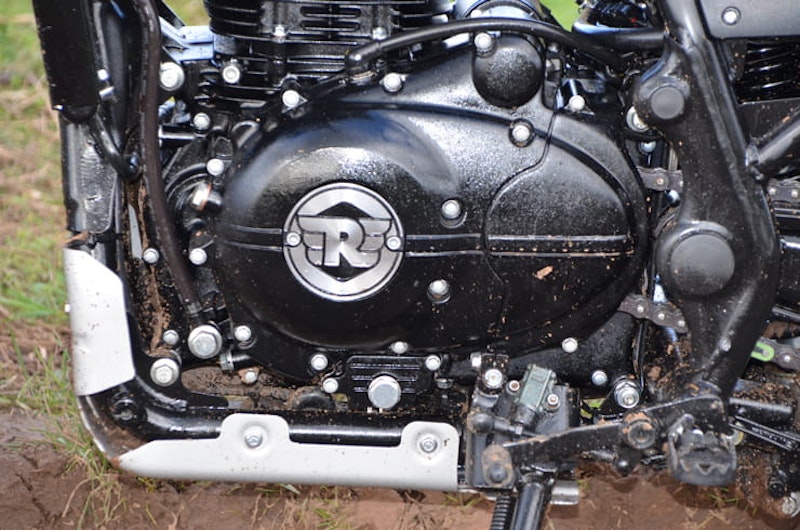The past catches up with us eventually. And so it is, the Royal Enfield Himalayan; a bike with the technology of an old British classic, built by a company of British origin, now in Indian hands, and finally, after a long year of wait, exported outwards to a global bike market more technologically driven - and obsessed - than ever.
The Himalayan lands rather awkwardly with just 24.5bhp, from a 411cc air cooled single overhead cam engine, fuel injection, ABS and a price tag of just £3999.
A Royal Enfield spokesman said of the bike:
“Our belief is that leisure motorcycling has gone extreme. Motorcycles are becoming super-fast, super-heavy, super-expensive and difficult to maintain. The youngsters don’t consider motorcycling as a hobby – I really want them to come back to looking at motorcycling less seriously. In today’s world we really feel that people have started to live in a virtual world – staring at a screen. We really want them to come back to the real world, to the world of motorcycling, explore the world they live in and have fun doing so.”
Having ridden the bike, that quote sets the scene quite nicely.
Royal Enfield Himalayan engine and chassis
The Himalayan is an all new design by Royal Enfield. Harris Performance Products in Hertford - acquired by Royal Enfield in 2015 - worked on the chassis, whilst the engine is the first SOHC engine Royal Enfield has built. The chassis is a half-duplex cradle frame, and that, along with the rather hefty looking long stroke engine helps contribute to the bike's not so featherweight 191kg kerb weight (measured with 90% fuel on board).
The rest of the bike is what you might call basic. The suspension at the front is a 41mm conventional fork (not upside down), with 200mm of travel and no adjustment. The rear monoshock (Royal Enfield’s first mono-shock bike) has 180mm of travel and is adjustable for preload only. The brakes are single disc front and rear, with a 300mm disc at the front with twin piston callipers, with a single piston calliper and 240mm disc at the rear. The brakes are by ByBre, Brembo's Indian sub-division, and are also fitted to the BMW G 310 GS and KTM's smaller capacity Duke range.
Ground clearance is an adequate 220mm (20mm more than a BMW G310GS, 75mm less than a Honda CRF250 Rally), whilst the seat height is low at 800mm; the same as a V-Strom 250 and less than most other adventure machines. A fuel tank of 15-litres isn't huge, but it's four litres bigger than the G 310 GS and five litres larger than that of the Honda CRF250 Rally, and with a reported 70mpg, the bike should manage 200 miles to a tank, and then some.
Royal Enfield Himalayan initial problems
It hasn’t been an easy ride for the Himalayan to reach this point. The first batch of bikes launched in India almost two years ago were plagued by a series of problems, and by the power of the internet many people got to know about them. The troubles began even before that when a promotional video unwittingly put out by Royal Enfield showed the bike landing from a jump and the foot peg breaking off. Hardly good PR but then it’s not really a bike for jumping.
The issues with the bike were fairly extensive, from wiring looms breaking down, coils packing up, steering head bearings failing, clutch plates seizing, fork legs corroding, paint from the filler neck grinding into the tank and blocking the fuel lines... a whole manner of issues on what was the launch bike's original designation; the BS3 model. Production was halted and by all accounts some 36 changes and improvements were made to the bike, as well as the fitment of fuel injection to replace the carb, finally culminating in the BS4 model, which is the model we’re receiving in the UK. To meet Euro 4 emission regulations, the bike also comes with non-switchable ABS.
Royal Enfield Himalayan first impressions
In the flesh the Himalayan is much more than you imagine it's going to be. It's bigger for a start, you'd almost class it as a mid-sized bike. With an absence of plastic panels it also looks quite stripped back and rugged. Colours are black or white. In black there's almost something stealthy about it and poking and prodding around the bike doesn't feel flimsy like a Chinese bike might, or even dare I say it a budget Japanese machine. The welds are neat and the paintwork functional. The paint on the tank is a matt finish. I've no doubt it'll show up scratches, but you get the sense that this bike isn't for polishing.
The clocks are functional and clear to read. There’s read outs for revs, speed, gear position and even a digital compass. The bike comes with a side stand and centre stand as standard, which is a nice touch considering a centre stand is often a £200-£300 optional extra with many adventure machines. A 21-inch front wheel - with a 17-inch rear - gives the bike a nice aggressive stance, whilst Pirelli MT60 dual sport tyres as standard offer more authority than the various models of lesser known brand IRC that come on Suzuki, Kawasaki and Honda's mini adventure machines. Aluminium panniers are a £500 optional extra. Brake hoses are braided.
The whole package is reminiscent, in look and character, of the Armstrong MT500s, later branded as Harley Davidson - the old British military bikes - that have a simple sense of solid functionality and purpose. Here, there are a few let downs in the finish, notably the way rust spots have been protected on the underside of the end can by a liberal brush stroke of a grey Galvaroid-like paint. It looks messy and wouldn't please some, but it does give you a sense of a human hand involved in the making of this bike. The frame is welded by robots, but the finish clearly done by a man with a paint brush.
The engine starts easily. It sounds muscular at tickover; a little burble, with a nice throaty lift on throttle. The bike feels manageable to haul around. It could be lighter. Some say it should be lighter, but often those people are looking at it as a trail bike, and to look at it in that way perhaps leads to false expectation. I’d call this a travel bike, not a trail bike, with the front side frames perfect for attaching smaller soft luggage to and the rear rack (albeit a bit too small to get a dry bag on) fitted as standard.
Once astride the bike it feels narrow, with the weight set low in the frame and it certainly not a cumbersome machine between the legs. The handlebars help. They're set upright and have quite a wide spread, meaning good leverage and, discovered later, with a good amount of lock for slow tight turns. The seat foam feels squishy, a little too much so, but combined with the 800mm seat height it's very easy to place both feet flat on the ground.
I bought a Royal Enfield Himalayan
I should note that this was my own bike I was sitting on. I'd just bought it and was picking it up from the Northamptonshire dealer Cooperb. I'd bought the bike out of curiosity as much as anything else, with the intention of running it over the course of the year to see how it holds up and if, like some of us hope, the bike represents the turning of a corner for bikes aimed at, or suitable, for the travelling community. With the demise of many single cylinder thumpers (often due to emission regulations), there aren't many new bike choices left for people who want a solid travel bike that’s not going to break the bank. Meanwhile, the big brands continue to tell us we need 1200cc, electronic suspension and a TFT screen - and sometimes we do - but they have rather neglected the other end of the market, which is where, to me at least, the Himalayan has a chance of doing quite well.
The first time out on the bike was a touch tentative. I'd just recovered from a broken ankle and was taking it steady. The bike was also being run in, with a 300 mile first service interval, and then after that every 6000 miles for the oil, but rather annoyingly from the service manual, valve checks every 3000 miles. This isn't ideal due to cost and inconvenience, and also the need to stick to these intervals in order to retain the 24 month warranty. It should be noted that the twin cylinder engines in the Suzuki and Kawasaki also require 3000 mile services, so the Royal Enfield isn't alone (the Honda CRF250L is an impressive 8000 mile interval). The only defence is that once the warranty has expired, or if you're going to self-service the bike from the get go, then the simple screw and lock-nut style valve adjustment shouldn't be beyond the scope of most amateur mechanics, or travellers. Also, by all accounts from riders in India, once the 3000 mile check has been carried out, the valves don't move much after that anyway.
Royal Enfield Himalayan road test
On the move the bike feels immediately docile. It's well balanced at slow speed, the clutch feeds in gently, the rise of the revs from throttle input is clean, with good fuelling immediately noticeable from the new fuel injection by German firm Keihin, who also do the fuel injection for the likes of BMW, Honda and KTM. The bike is a little prone to stalling if you don’t meet the clutch biting point with a few revs – especially on muddy trails – and surprisingly in this day and age, the bike even comes with a choke for cold starting.
The ride quality is surprisingly plush. There's enough travel to soak up urban bumps, the bike feels stable under brakes, and whilst there's not a huge amount of bite from the front brake, there are owners already experimenting with different pads to see if this can be improved. The (same) brakes on the G 310 GS also lack bite, although that bike benefits from weighing 20 kilos less than the Himalayan, but with 24.5bhp we're not looking to stop a superbike. The rear brake would benefit from a little more feel, acting somewhat as an on or off switch. The bike has ABS but it’s unlikely to be called upon too often.
Out of the city and the bike builds speed smoothly with no sign of vibration through seat, feet, bars or mirrors. It has that wave of torque that you get from say a Bullet 500, but without the mechanical roughness that comes with it. It certainly feels a much more modern bike than a Bullet. With the long stroke engine configuration (the length of the stroke is greater than the diameter of the bore and therefore it won’t rev as high but will produce more torque) the engine pulls strongly from low revs, with torque measured at 32Nm at 4000rpm. By comparison the BMW G310GS makes 28Nm of torque, but not until 7500rpm. For reference, a Bullet 500 makes three more brake horsepower than the Himalayan, and ten more torques. Both bikes weigh about the same.
Otherwise on the road the bike feels competent. A 21-inch front wheel is always going to rob a bike of some sharpness and the dual sport Pirelli MT60 tyres aren’t going to offer the last word in cornering grip, but it all seems to work as a package. Most pleasing of all is the riding position and comfort. Arms reach nicely to the bars, the screen isn’t exceptional but keeps some wind buffeting off, and all in all, it feels like a bike you could do a lot of Tarmac miles on. With this bike still being run in, online consensus is that the Himalayan will cruise at between 60mph and 70mph with ease and will push on to 85mph maximum. Those who have tried say the bike is capable of hauling a passenger with relative ease.
The only question mark is that with the soft seat foam you do sink into it and feel in the bike rather than on it. At 5'10 I am comfortable on the bike, but taller riders over six feet might find themselves a little cramped in the leg and might need to bolster the seat with some thicker foam.
Royal Enfield Himalayan off-road riding
Keen to see what it's like on the dirt I take a long unpaved track which has a nice variety of terrain for assessing a bike. It's not overly challenging, and I suspect the Himalayan would be capable of tougher conditions, but as a place for getting to grips with the basics it's ideal. First thing to notice is that the standing position is spacious. The bars in their standard position are nicely rolled forward with your arms just ahead of you, rather than a hunch down to them as they are on the G 310 GS. They're just wide enough as well to give good leverage, and with the relatively low slung footpegs there's plenty of room on the bike when standing. There was initial concern that the flare in the side panels pushed out the calf area, splaying your legs more than you'd like, but after 5 minutes you soon adjust and it's no longer an issue, except for those with chunky calves who might have to do something with those side panels.
The suspension copes well with bumps. You can imagine it getting out of shape if you pushed on too hard, but at moderate speeds it has that nice blend of composure, suppleness and control. The last bike I brought along here was a Ducati Desert Sled and that struggled to cope with the chattering bumps and shallow and frequent ruts. The Himalayan rides better than the Ducati. It also steers well and the whole bike feels stiff and well framed. Some bikes feel sloppy stood up. This doesn't. The weight also balances nicely between your legs. Removeable foot peg rubbers are a nice touch, revealing a grippier metal base, whilst the Pirelli tyres cope as well as a dual sport tyre might in these conditions, although I’d like to see how the bike ran on a pair of Continental TKC80s for example.
Once again, what impresses is the low-down chug of the engine, the bike accepting second almost from the pull-away and happy to bob along at slow speeds and low rpm without any snatch or judder. The fueling is very good, and the whole bike novice friendly. The ABS isn't switchable, which is a shame, especially when it can be an annoyance off-road, but the removal of a fuse would do the trick for those desperate to disengage it. The foot controls are also nicely placed. It's easy to dab the back brake. The gear lever equally sits nicely for up and down changes, and the gearbox generally feels positive and clean. It snicks into gear cleanly and whilst at 190 kilos the bike’s never going to be good at motocross, it does make light work of the type of trails most people are going to tackle. The only thing lacking is a crud catcher to keep mud off the rear shock which soon becomes caked in mud.
I emerge from the woods quite relieved with how the Himalayan rides. It's not a Dakar bike, nor a KTM, nor a CRF250L weighing 45 kilos less. But it is a bike that's clearly as happy on the trails as it is on the road. You could comfortably go around the world on this bike.
Royal Enfield Himalayan conclusion
I think what strikes you as you ride along is the way in which the bike seems to have been designed as a package from the ground up. The engine suits the chassis, the chassis suits the suspension, the suspension suits the ergonomics and together it feels a well-rounded product. By comparison, most other small capacity adventure machines are compromised in one way or another. The Kawasaki Versys-X 300 has to make use of the high revving engine from the Ninja 300 sports bike, the Suzuki V-Strom 250 is a re-working of the Inazuma commuter bike, the BMW G 310 GS shares its platform with the road-orientated R model and the Honda CRF250 Rally is a CRF250L dressed up to do highway work and is compromised slightly as a result. With the Himalayan you don’t sense that compromise has had to have been made because it was new from the ground up.
Factor in price and the Himalayan also makes good value. It's £600 less than the V-Strom 250, £1149 less than the Versys X300, £1100 less than the BMW and with Honda's price increase for 2018, £1400 less than the CRF250 Rally, which is incredibly difficult to justify.
The only question mark is reliability. Reports of the BS4 model so far show it to be much more robust than the BS3, with a constant rumour that export bikes are built on separate production lines to make double sure of their construction. An initial batch of 500 bikes are allegedly ear marked for the UK. There is a rumour that once those bikes have been sold then there will be a price wise. How much of a price rise no one is certain. Ideally it wouldn’t be by much, because at £3,999, combined with the way the bike rides, and importantly the way the bike feels – solid, chunky, different - then the Himalayan almost becomes a no brain option for anyone looking for a bike just to enjoy for what it is. Low tech, low speed, but a capable and well-balanced package. The past has most definitely caught up with us with this bike, but on first impression, I don’t think that’s no bad thing.
Royal Enfield Himalayan (2018) | Road test review
Can the adventure bike from India make a dent in the BMW GS market?



